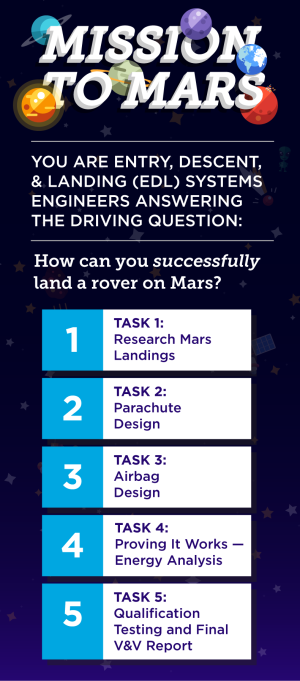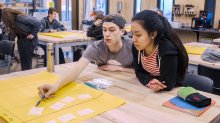How Can We Successfully Land a Rover on Mars?
The classic egg drop experiment gets reinvented as a driving question for physics students to explore a real-world problem.
Your content has been saved!
Go to My Saved Content.When a teenager climbs atop his desk and drops an object to the floor, teacher Johnny Devine doesn’t object. Far from it—he’s as eager as the rest of the class to see what happens next.
In a split second, the student and his teammates get positive feedback for the object they have cobbled together by hand. A small parachute made of plastic and held in place with duct tape opens as planned, slowing the descent and easing the cargo to a safe landing. Students exchange quick smiles of satisfaction as they record data. Their mission isn’t accomplished yet, but today’s test run brings them one step closer to success as aspiring aerospace engineers.
To boost engagement in challenging science content, Devine has his students tackle the same problems that professional scientists and engineers wrestle with. “Right away, they know that what they are learning can be applied to an actual career,” Devine says. “Students are motivated because it’s a real task.”
The Mission to Mars project is one of five project-based learning (PBL) units in an Advanced Placement Physics course at the Science and Math Institute in Tacoma, Washington, better known as SAMi. The small public high school, located on the grounds of Point Defiance Zoo, emphasizes learning by doing and connections to community resources and experts.
From the start of Mission to Mars, students know that expert engineers from local aerospace companies will evaluate their final working models of Mars landing devices. Their models will have to reflect the students’ best thinking about how to get a payload from orbit onto the surface of the Red Planet without damaging the goods inside. While real Mars landings involve multimillion-dollar equipment, students’ launchers will carry four fragile eggs.
The Road Map
Although the project gives students considerable freedom, it unfolds through a series of carefully designed stages, each focused on specific learning goals. Having a detailed project plan “creates a roadmap,” Devine explains, “for the students to really track their progress and see how what they’re learning connects back to the guiding question: How can we successfully land a rover on Mars?”

Before introducing technical content, Devine wants students to visualize what space scientists actually do. By watching videos of engineers who design entry, descent, and landing systems for spacecraft, students start getting into character for the work ahead.
Devine introduces a series of hands-on activities as the project unfolds to help students put physics concepts into action. They learn about air resistance, for instance, by experimenting with parachute designs and wrestling with a real challenge: How will they slow their landers to a reasonable speed for entry into the thin Martian atmosphere?
To apply the concept of change in momentum, students design airbag systems to go on the bottom of their landers—a location aptly called the crumple zone. They experiment with bubble wrap and other materials as potential cushioners for their cargo.
As the grand finale approaches, students keep using what they learn to test, analyze, and modify their designs. “You have to repeat the equations with different trials,” one student explains. “Being able to use that math over and over again helps it stick.”
Much of the hands-on learning in this PBL classroom “might look like a traditional physics lab,” Devine acknowledges, with students learning concepts through inquiry investigations. What’s different is the teacher’s ongoing reminder “to make sure students stay in character” as systems engineers. Each lab investigation relates back to their driving question and creates more opportunities for Devine to ask probing questions and formatively assess his students’ understanding. “We do a lot of framing in and framing out after each of those lessons so students have the chance to reflect and connect it back,” the teacher explains.
Expert Conversations
When it is finally time for students to launch their precious cargo off a second-story landing, engineers from local aerospace companies are standing by to assess results. How many eggs in each lander will survive the fall?
Even more important than the test data are the discussions between experts and students. One engineer, for instance, asks to see earlier versions of a team’s design and hear about the tests that led to modifications. A student named Elizabeth perks up when she hears engineers using the same technical vocabulary that she and her classmates have learned. “It was kind of a connection—this is actually a thing that goes on,” she says.
“They had really deep, meaningful conversations so that students could practice communicating their justification for their designs,” Devine says. Hearing them use academic language and apply physics concepts tells the teacher that students deeply understand the science behind their designs. “At the end of the day, that’s what I’m most concerned about,” he says.
Managing Like Pros
Just like NASA scientists who collaborate on complex space missions, students work in teams on the Mission to Mars project. Devine has learned from experience that students may not know how to collaborate effectively. That’s why he teaches them to use the same project management strategies that the pros use.
One go-to strategy is the scrum. It’s a protocol for fast-paced daily team meetings. Students use a poster to track progress and assign tasks. Each team member contributes to the discussion by answering three key questions:
- What have I accomplished since the last meeting?
- What am I going to work on between now and our next meeting?
- What issues or concerns do I have about the project currently?
Technologists and software developers use the same method to troubleshoot problems and keep complex projects on track. In a PBL classroom, Devine says, the scrum “gives students language to hold each other accountable.” They can see at a glance if tasks are evenly distributed among team members. For the teacher, the scrum poster provides a useful formative tool: “It gives me a gentle way to interject if students are off task,” he says.
Engineers who visit Devine’s class reinforce the value of what students gain through Mission to Mars. “To have the experts come in and say, ‘This is what we do on a daily basis. These are skills I wish I had developed more when I was your age’—that has a really meaningful impact,” Devine says.
